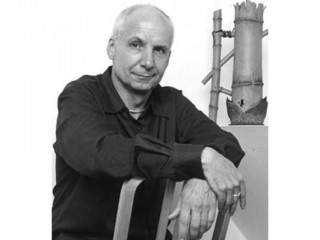
Anthony Caro biography
Date of birth : 1924-03-08
Date of death : 2013-10-23
Birthplace : London, England
Nationality : British
Category : Arts and Entertainment
Last modified : 2014-01-28
Credited as : Sculptor, Sir Anthony Caro, modernist school
The English sculptor Anthony Caro worked in steel and aluminum, often painted in primary colors. His welded and steel constructions explore the eccentricities of balance, weightlessness, and horizontal composition.
Anthony Caro was born in London on March 8, 1924. He took a degree in engineering at Cambridge and served in the navy during World War II. He studied at London's Regent Street Polytechnic School (1946-1947) and the Royal Academy Schools (1947-1952). He worked as a part-time assistant to the sculptor Henry Moore (1951-1953) and then began to teach at St. Martin's School of Art in London.
The period of training with Moore left its mark on Caro's work throughout the 1950s. Moore's impact was revealed not only in Caro's intense interest in the nature and inherent properties of the various materials with which he worked but also in his retention of the human form cast in bronze. It was not until 1959, the year of his first visit to America and his first-hand acquaintance with the new trends in art—principally the work of the painter Kenneth Noland and the sculptor David Smith—that Caro abandoned figurative sculpture.
Caro began working in steel and aluminum in 1960. First he used large metal shapes either cut with a torch or piled up off the ground as ready-made I beams. Then he moved away from these compact masses and began to stretch individual parts of a composition across the ground plane, often painting them in a single, unifying color. By 1962 he had enlarged his angular formal vocabulary by including in certain works thin ribbons of steel tubing, often gracefully bent and sometimes seemingly suspended in midair, which achieved a light and graceful mood. At the same time Caro continued to compose directly on the ground plane without any pedestal, and his compositions became increasingly complex and flamboyant. The culminating works of this period, Bennington and Titan, were executed in 1963.
Caro's work then took several directions. He began to simplify his compositions, often following a single directional line and using a variety of new shapes and materials, ranging from steel cylinders to metal mesh. But he simultaneously concerned himself with smaller, exquisitely refined pieces, adjusted to a more intimate space. These smaller works, executed in 1966 and 1968, are of polished and painted steel; they often have a boxlike support or pedestal not only to raise them to a more comfortable viewing height but to serve as a fulcrum for the compositions. Caro also continued to experiment with a vast repertoire of materials and to explore the full spectrum of scale relationships that made him one of the most formative influences on the younger generation of British sculptors.
Caro's career continued unabated well into the 1990s. In 1993 Caro returned to creating semi-figurative sculptures for the first time since the 1950s. These were clay figures made in combination with metal and wood; the subject of this series, which consisted of more than 40 pieces, was the Trojan War. At the same time, Caro continued to produce massive abstract steel sculptures, many of which are essentially architectural in nature. In 1996, his work Goodwood Steps was called Great Britain's largest work of sculpture. Located on the Sussex landscape, it was a series of massive forms marching across the countryside in a pattern that recalled the giant standing stones at Stone Henge.
Caro was awarded a knighthood in the Queen's Birthday Honors of 1987. He has also received honorary degrees from universities and art schools in Britain and around the world. In 1995, a large retrospective exhibition of his work was shown at the Metropolitan Museum of Art in Tokyo, the museum's inaugural show.
Although there is information on Caro in museum catalogs of his work, there is no monograph on him. Useful background sources include Michel Seuphor, The Sculpture of This Century (trans. 1960); Eduard Trier, Form and Space: The Sculpture of the Twentieth Century (trans. 1961; rev. ed. 1968); A. M. Hammacher, Modern English Sculpture (1967); and Jack Burnham, Beyond Modern Sculpture (1968).
Caro was 89 when he died of a heart attack on 23 October 2013.
















